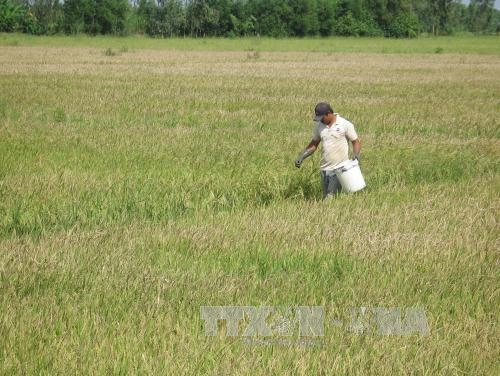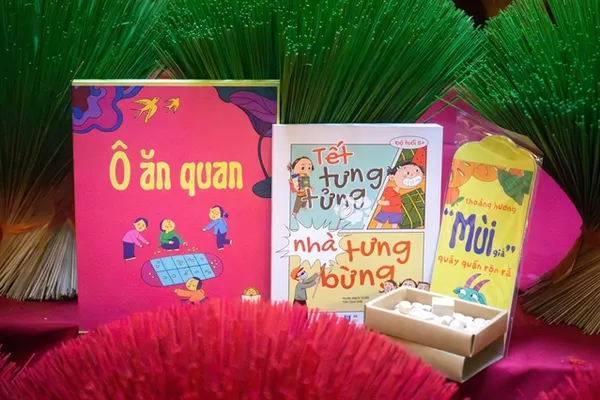 Society
Society

Farmers in the Cửu Long (Mekong) Delta have begun harvesting the year’s third rice crop, but face low yields even as prices have been pushed down by export difficulties.
 |
| Many autumn-winter rice fields in Vị Thuỷ District in the Cửu Long (Mekong) Delta province Hậu Giang are affected by bacterial leaf blight disease. — VNA/VNS Photo Duy Khương |
HCM CITY — Farmers in the Cửu Long (Mekong) Delta have begun harvesting the year’s third rice crop, but face low yields even as prices have been pushed down by export difficulties.
Nguyễn Văn Xiêm Nhỏ of Phú Đức Commune in Đồng Tháp Province’s Tam Nông District said his area had grown three rice crops a year for many years, but this year’s yield has been the lowest.
“In the previous autumn-winter rice crop, the yield was 5.5 -6 tonne per hectare, but this year the yield is less than 5 tonnes.”
Bad weather and disease outbreaks have also increased production costs but prices are low, causing farmers losses, he said.
In other delta provinces like Hậu Giang and Kiên Giang too farmers are worrying about a poor autumn-winter harvest.
Danh Hậu, head of Giồng Kè hamlet in Kiên Giang Province’s Hòn Đất District, said 1,000ha of winter-spring rice was earlier damaged by drought and saltwater intrusion.
Now farmers face a poor harvest because of diseases, he said.
Many had left the place for HCM City and Bình Dương Province to find jobs, he added.
The price of the grain in the delta has fallen significantly compared to some months ago, according to local farmers.
Nguyễn Thị Nguyệt, who has harvested two hectares of rice in Đồng Tháp Province’s Tam Nông District, said: “Traders try to push rice prices down between VNĐ4,000 and 4,600. If I sell rice at these prices, I will suffer losses.”
Dương Phương Thảo, deputy head of the Ministry of Industry and Trade’s Export and Import Department, said paddy prices have been falling because of large inventories caused by difficulties in exporting.
The delta plans to grow 867,000ha this autumn-winter, and farmers have sowed more than 700,000ha so far, according to the Ministry of Agriculture and Rural Development (MARD).
More than 110,000ha, planted early, have been harvested so far.
This year many farmers sowed the autumn-winter crop one month earlier than usual because the flood season was unusually brief.
The annual flooding caused by the rising levels of the Mekong River and its tributaries between August and November brings silt to the rice fields and destroys pests such as mice.
Higher-profit crops
Nguyễn Văn Thể, secretary of the Sóc Trăng Province Party Committee, said the delta’s farmers have contributed greatly to the country’s food security and rice exports for many years, but the number that has become rich from growing rice is not high.
Increasingly bad weather and saltwater intrusion deep into rivers affect rice cultivation the most, he said.
Besides, rice prices are declining while fruit prices are rising because of increased exports, he said.
Sóc Trăng farmers who grow green-peel and pink-flesh grapefruit make an average profit of VNĐ300 million (US$13,600) per hectare every year, many times higher than from rice.
Similarly, farmers who breed shrimps also make many times more profits.
“Sóc Trăng does not require its farmers to grow rice at any cost. Farmers should calculate to switch to other crops that are suitable for each place and meet market demand.”
According to Nguyễn Văn Dương, chairman of the Đồng Tháp Province People’s Committee, in restructuring agriculture the province has made rice only one of five key produce.
Other produce like flowers and ornamental trees, mangoes and ducks yield better profits than rice, and so the province is focusing on them.
In areas zoned for rice, the province has reorganised production by bringing together farmers and enterprises to reduce costs and increase profits.
After three years of restructuring agriculture, the delta – the country’s largest rice, fruit and seafood producer – has switched to growing other crops like sesame, corn, soy bean and vegetables on more than 78,000ha of less fertile rice fields, according to MARD.
These crops offer 20-30 per cent higher profits.
Minister of Agriculture and Rural Development Nguyễn Xuân Cường said fruit trees and aquaculture had potential for development and could help farmers become rich.
The agriculture sector should focus on developing fruit trees and aquaculture based on global demand and response to climate change, he added. — VNS




